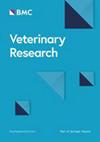实验感染的骡鸭中两种 2.3.4.4b 支系 H5 高致病性禽流感病毒的病毒脱落和环境散布:对环境采样的影响
IF 3.7
1区 农林科学
Q1 VETERINARY SCIENCES
引用次数: 0
摘要
近年来,高致病性禽流感病毒(HPAIVs)引发了严重的流行病,给世界各地的家禽和野生动物造成了毁灭性的后果。家鸭和野鸭对高致病性禽流感病毒高度易感,感染后会导致病毒的高效复制和大量脱落(即长期高滴度),从而造成病毒的广泛传播。重要的是,已知鸭在感染初期会大量脱落病毒,但环境污染对高致病性禽流感流行病学的动态和影响却鲜为人知。在本研究中,我们监测了在 2016-2017 年和 2020-2021 年法国流行病疫情中实验性感染两种 H5N8 2.3.4.4b 支鹅/广东高致病性禽流感病毒的骡鸭。我们研究了口咽、泄殖腔、结膜和羽毛中的病毒脱落动态;鸟与鸟之间的病毒传播;以及环境在病毒传播和作为早期检测和监测样本来源中的作用。我们的研究结果表明,病毒脱落在临床症状出现之前就开始了,即早在接种后 1 天(dpi)或接触后就开始了,在 4 dpi 达到高峰,并持续 14 dpi。在气溶胶、灰尘和水样中检测到的病毒 RNA 反映了病毒的脱落动态,在整个实验过程中,从这些环境样本中成功地分离出了病毒。我们的结果证实,骡鸭在无症状的情况下可通过四种排泄途径(口咽、泄殖腔、结膜和羽毛)排出高滴度的高致病性禽流感病毒,环境采样可作为一种非侵入性工具,用于感染高致病性禽流感病毒的猪场的早期病毒 RNA 检测。本文章由计算机程序翻译,如有差异,请以英文原文为准。
Viral shedding and environmental dispersion of two clade 2.3.4.4b H5 high pathogenicity avian influenza viruses in experimentally infected mule ducks: implications for environmental sampling
High pathogenicity avian influenza viruses (HPAIVs) have caused major epizootics in recent years, with devastating consequences for poultry and wildlife worldwide. Domestic and wild ducks can be highly susceptible to HPAIVs, and infection leads to efficient viral replication and massive shedding (i.e., high titres for an extended time), contributing to widespread viral dissemination. Importantly, ducks are known to shed high amounts of virus in the earliest phase of infection, but the dynamics and impact of environmental contamination on the epidemiology of HPAIV outbreaks are poorly understood. In this study, we monitored mule ducks experimentally infected with two H5N8 clade 2.3.4.4b goose/Guangdong HPAIVs sampled in France in 2016–2017 and 2020–2021 epizootics. We investigated viral shedding dynamics in the oropharynx, cloaca, conjunctiva, and feathers; bird-to-bird viral transmission; and the role of the environment in viral spread and as a source of samples for early detection and surveillance. Our findings showed that viral shedding started before the onset of clinical signs, i.e., as early as 1 day post-inoculation (dpi) or post-contact exposure, peaked at 4 dpi, and lasted for up to 14 dpi. The detection of viral RNA in aerosols, dust, and water samples mirrored viral shedding dynamics, and viral isolation from these environmental samples was successful throughout the experiment. Our results confirm that mule ducks can shed high HPAIV titres through the four excretion routes tested (oropharyngeal, cloacal, conjunctival, and feather) while being asymptomatic and that environmental sampling could be a non-invasive tool for early viral RNA detection in HPAIV-infected farms.
求助全文
通过发布文献求助,成功后即可免费获取论文全文。
去求助
来源期刊

Veterinary Research
农林科学-兽医学
CiteScore
7.00
自引率
4.50%
发文量
92
审稿时长
3 months
期刊介绍:
Veterinary Research is an open access journal that publishes high quality and novel research and review articles focusing on all aspects of infectious diseases and host-pathogen interaction in animals.
 求助内容:
求助内容: 应助结果提醒方式:
应助结果提醒方式:


